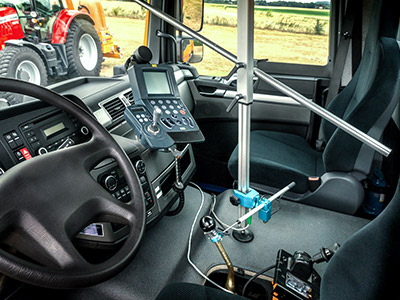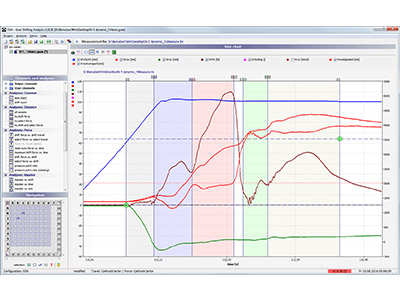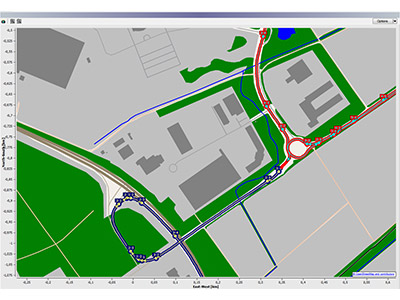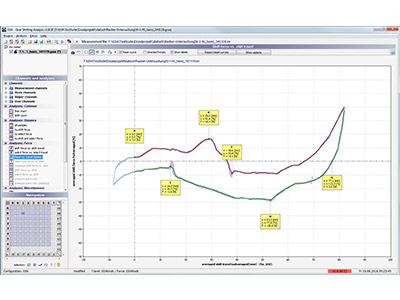Gear shift analysis and clutch analysis for manual transmissions
Due to the high demand, cars with manual transmissions are still being developed in Germany and Europe. In order to determine the quality of shifting for the user at an early stage, ATESTEO offers the innovative GSA gear shift analysis, which measures and analyses the shifting forces and shifting travel directly in the vehicle at the shift lever and then provides you with a tabular evaluation. In order to identify clutch-related NVH phenomena in vehicles with manual shifting as early as in the development of the powertrain, we also offer the innovative CA clutch analysis.
Custom tailored GSA gear shift analysis
As characteristics of a certain vehicle brand, quality and feeling during shifting the vehicle deliver a decisive contribution to one’s personal driving experience. Subjective estimations of the experience depend on the experience of the person judging and can lead to discussions of the evaluation criteria. The GSA gear shift analysis system is a user-friendly tool to support you in improving the quality of shifting and to deliver you objective characteristic values.
Benefits of gear shift analysis with GSA system
- Measurement of the shifting forces and shifting distances at the gear stick. Clutch power and displacement along with further analog signals and CAN signals are optional.
- User support for the conducting of the measuring programme.
- Analysis and sorting of the characteristic values in an easy-to-read form with the help of a variety of filters.
- Display of the analyzed values in user-defined tables and typical diagrams.
- Possibility of comparing the results of various analyses across more than one project.
With its GSA system, ATESTEO delivers you a tool for optimising synchronised manual transmissions. Objective characteristic values to assess shifting quality are produced from the analysis of the measured data. The GSA system makes available the hardware to collect, process, and visualise the relevant data in the vehicle or test bench. The experience of our specialists and of many customers all over the world has made the GSA system a tool to improve shifting quality recognized all over the globe.
The GSA system for objective gear shift analysis of the shifting mechanism
The GSA gear shift analysis system is used during development of synchronised manual transmissions. It can be used to check the functionality and behaviour of the gear changes; that is, shifting from gear to gear. The gear shift analysis tool GSA, which was developed by ATESTEO, has proven in many years of testing to be a valuable tool, mainly by complex transmission and gear development projects. The GSA system is not only applied for objectively assessing the change of gears in a vehicle. During the new development and integration of transmissions, transmission component testing, lubricant comparisons, and quality assurance, the GSA gear shift analysis system is indispensable as the right tool. The tool permits measuring and analysing the influencing factors of gear shifting quality. The GSA system, which has matured after being used many times, enables analysis optimally adapted to your requirements and needs.

Functionality and reliability of results of the GSA systems
The GSA system is applied in passenger cars or trucks. It can be optimized for left- and right-hand drive vehicles and supports you doing the following:
- Comparing vehicles
- Comparing vehicle concepts (competitors, design, suppliers’ products)
- Comparing development phases (design iteration)
- Comparing various production lines
- Comparing durability- and temperature-dependent influences
- Comparing subjective evaluations using objective characteristic values
- Analysing of internal and external shift mechanisms
- Improving gear changing (shifting) quality
Characteristics of the GSA gear shift analysis tool

- Quick and easy installation of the measuring equipment.
- Low inertia and friction minimise the influence of the measuring equipment on measurement results.
- User-friendly navigation through any number of measurement tasks during dynamic and static measurements (e.g. free play, stiffness and detent mechanism tests).
- Automatic determination of gear changes and shifting phases. The results can then be reviewed graphically and, if necessary, be adjusted.
- Calculation of important parameters (e.g. rpm lift, shifting speed, momentum, energy).
- Display of the calculated values as a function of shifting types, shifting phase, relative time, and travel.
- Statistical values, such as minimum and maximum values, time values, and force ratios, are determined as a function of shifting events and shifting phases, and are listed in the table form as the user defines.
- By exporting the specific values to Microsoft Excel®, further parameters can be determined and processed into the desired form.
- A comparison function supports loading several measurement projects. The simultaneous display of project parameters shows the existing differences in a clearly structured form.
- With the help of the measured GPS data, the shift events can be displayed and evaluated in relation to the given locations (OpenStreetMap®).
The four components of the GSA system for gear shift analysis
The complete hardware and software for collecting, viewing, and analysing the necessary data is included in the GSA system. Generally, the measuring tasks and measurement values can be customised. In addition, the system contains detailed methods for determining the static and dynamic characteristic values of gear shifting. Many predefined charts, filtering, and comparison features assist in quickly documenting the analysis results. The data can be exported to well-known office applications. The software also contains further tools for documentation.
- GSA measurement hardware
- GSA measurement device
- GSA data capture software
- GSA analysis software

GSA measurement hardware for gear shift analysis
Sensors for recording the shifting travel and forces are included in the GSA measurement hardware. The sensor systems may be built into virtually all passenger vehicles. For commercial vehicles, trucks, and delivery vans, special solutions can be made available as a rule. Owing to their sophisticated mechanics, the sensor systems can be installed in the vehicle in about 15 to 20 minutes. The installation position has no influence on the measured values. The original vehicle shifting knob is replaced by a special shifting knob. This can record the shifting forces in the three Cartesian dimensions. The knob is clamped onto the gear lever with a simple device. Shifting travel and forces can be projected onto the position of the original shifting knob by software. The three-point mounting of the sensor system on the vehicle floor, roof lining, and windshield ensures secure and twisting-resistant positioning. Rotational speed and temperature sensors help in the evaluation of outer influences and in the analysis of different measurement procedures.
GSA measurement device for gear shift analysis
The data of the entire sensor system is processed into high-quality measurement values using a measurement device from the Imc company. The combined sampling rate of the device is 400 kHz. The measurement devices appropriately carry the label “Made in Germany”. They display their excellence in high reliability and precise measurement values at high sampling rates. The modular design of the measurement devices allow perfect adaptation of the number of measurement channels to the measurement requirements.

GSA data capture software for gear shift analysis
The GSA data capture software offers flexible configuration of the measurement project which is used to readjust the test design. Information on the vehicle and the driver can be entered. The arrangement of the vehicle gears is taught-in once before the start of measurement. Additional measurement points can easily be set up and displayed in user defined charts and displays.
A distinction is made between static (motor off, stationary) and dynamic measurements (measurement trips). For both measurement types, measurement procedures which provide optimum measured data for appropriate analysis specifications have been developed by ATESTEO. Shifting procedures are recognized by the software during measurement. The shifting duration and shifting force for a shifting procedure can be displayed. This helps in compliance with target shifting times and forces. A remote control ensures easy and secure operation during a measurement trip. A user-friendly storage path and text and speech comments help to organise the measurement data.

GSA analysis software for gear shift analysis
Using the GSA analysis software, the recorded measurement data can first be loaded and viewed. The automated analysis algorithm provides a special analysis mode for each measurement procedure so that the measurement data can be preliminarily evaluated very quickly. Static values and custom tailored charts are prepared. A list of all shifting processes and their properties (synchronization duration, synchronization impulse, rpm lift, maximum synchronization force, etc.) is created during the analysis of the dynamic measurements (measurement trips). The software divides each shifting process into the characteristic shifting zones:
- Disengagement
- Preliminary synchronization
- Synchronization zone
- Blocking zone
- Free flight
- Double bump
- Overpushing
The results of the preliminary analysis can be quickly adapted to the individual requirements because of the simple operating concept. Shifting zones can be modified and shifting processes can be selected for analysis using the Shifting Navigator. A combination of shifting types is supported by the Navigator (2-3, 3-2). The analysis results can be quickly restricted by selecting shifting processes. Shifting processes and analysis results can be displayed in numerous, pre-defined charts as a function of gear, travel, force, rotational speed, and temperature. Shifting impulses and shifting forces and their shifting zones are calculated by the GSA analysis software for each shifting process. For the depiction of additional measurement channels, y(t) and xy diagrams can be used. The existing measurement and conversion values can be assigned individually to the abscissa and ordinate axes in the course of this. The static data of the selected shifting processes can be exported into Excel-compatible files. Diagrams can be exported as pictures for presentations, etc. Special depiction forms can be implemented to meet the needs of individual customers.
Contact us
You would like to carry out individual clutch analyses with ATESTEO according to your special requirements? Or do you have questions regarding the GSA gear shift analysis? Our experts are looking forward to your contact request.
We are looking forward to your message!
Innovative clutch analysis for trouble-free gear shifting
Some NVH (noise, vibration, harshness) phenomena are influenced directly or indirectly by the clutch. The clutch can pull up. That means that unexpected vibrations occur in the drivetrain. Or the axles squeal. The clutch analysis (CA) system can be used to identify these kinds of possible issues with the vehicle while it is in the early stages of development.
The clutch analysis system (CA) supports doing the following
- Comparing vehicles
- Comparing vehicle concepts (competitors, design, suppliers’ products)
- Comparing development phases (design iteration)
- Comparing various production lines
- Comparing durability and temperature-dependent influences
- Comparing subjective evaluations using objective characteristic values
- Improving clutch behaviour and operability
Occurring problems can be detected, identified and eliminated with the coupling analysis. For this purpose, the CA system was developed as a clutch analysis system by ATESTEO for objective analysis of the clutch mechanism and the clutch hydraulics in vehicles with manual transmissions. The clutch analysis system is used in both vehicles and test benches.
The three components of the CA system for clutch analysis
The clutch analysis CA measurement hardware
The measurement hardware includes a pedal force sensor and a cable-pull potentiometer. The actuation forces clutching distances are measured using these two basic sensors. In addition, temperature and rotational speed sensors can also be integrated into the system.
The clutch analysis (CA) measurement device
The data of the entire sensor system is processed into high-quality measurement values using a measurement device from the Imc company. The combined sampling rate is 400 kHz. The Imc devices sold with the GSA system are compatible with the clutch analysis (CA) system.
The clutch analysis (CA) software
The measurement data are recorded and analysed using the clutch analysis (CA) software. At the same time, the program guides the user through the entire measurement procedure. After the recording of the characteristic hysteresis curves, further defined clutching points are travelled to and measured. All data is stored as a project.
Possibilities of the CA Coupling Analysis Software
- In the analysis mode of the software, measurements can be loaded, depicted, and processed and analysed. The clutching positions measured by the software can be offset if required.
- Additional, user-defined clutching positions can be measured out manually.
- The multiple analyses offer the option of comparing any number of measurements.
- Multiple clutching curves can be averaged.
- An option is available for storing the results as PDF, Word, or Excel documents or as websites.
- Additional analysis methods are available to the user through export into Excel in CSV format.
- The pure measurement data are stored in RAW format and can be viewed and analysed using the Famos program from the Imc company.
Compatibility and adaptability of the clutch analysis (CA) software
The CA software is an ATESTEO in-house development. As a rule, the applications can be adapted to customer wishes. The target systems are Windows XP and Windows 7. No further software subject to licensing requirements is needed. The clutch analysis (CA) system is generally sold in conjunction with the GSA gear shift analysis system as a particularly effective combination.
Custom clutch analysis for customer-specific requirements
The basis for the evaluation is the pedal forces and distances at the clutch pedal. In addition, temperatures and engine speed can be measured at the same time for more detailed analyses. The clutch analysis system includes the entire hard and software for recording, viewing, and analysing the necessary data. The measurement tasks and the measurement values can generally be adapted to meet customer wishes.
Download
All further information on gear shift analysis with our GSA system can be found in our current brochure.

